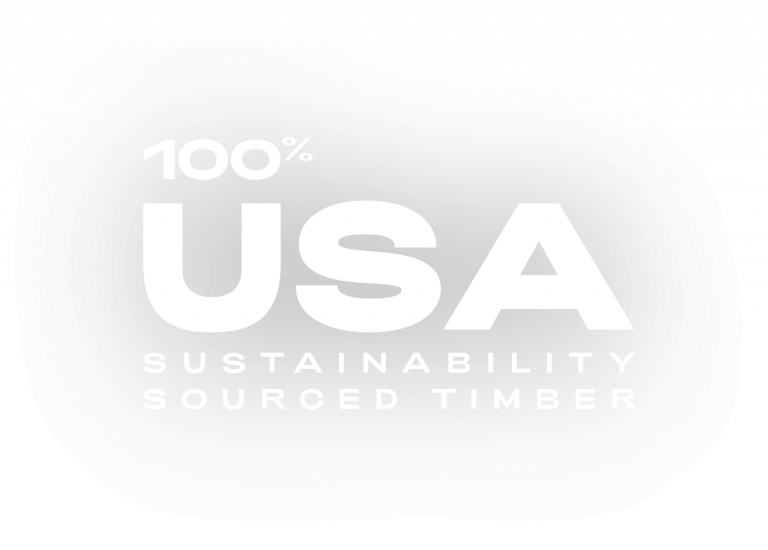

Compared to its material counterparts, wood is the most sustainable material due to its natural attributes which benefits the entire supply chain.
The table shows the amount of energy, measured in mega joule, needed to produce one kilogram of finished product. The energy required to produce 1 kg of kiln dried hardwood is monumentally less than the energy needed for an equivalent of plastic or aluminium.


Vinawood is committed to conducting, sourcing, and manufacturing practices that emphasizes sustainable forest management and environmentally friendly coating. We partner with United States and Japanese entities which comply to the rule of law and legally harvest its timber.
We source from suppliers who engage in professional foresters who manage the timberland and exercises sustainable forest management. Certified by the Society of American Foresters, these professionals are integral to ensuring the vendors hardwood forests are collectively growing up to twice as much as it is harvested annually. The U.S. Forest Service’s recent studies confirms this outcome.
Our partner suppliers are members of multiple organizations which commit to sustainable forestry practices such as the following:


The possibility that a hardwood product from the United States is procured from an illegal or unsustainable source is minimal.
The study’s primary results from 2017 Seneca Creek (Assessment of Lawful Sourcing and Sustainability: U.S. Hardwood Exports) offer a transparent and obvious indication of the potential hazards (or, more precisely, the absence thereof) encountered by individuals engaged in the trade of hardwoods from the United States.
Based on the criteria established by the EU Timber Regulation, the Australia Illegal Logging Prohibition, Japan’s Goho program, and the due diligence and risk assessment requirements of certification programs (FSC®/SFI®/PEFC®) that operate within the United States, it can be concluded that all states in the hardwood-producing region of the United States pose a Low Risk of sourcing illegal hardwoods.
From a national or state standpoint, the harvesting rate of hardwoods in the United States that poses a problem for sustained yield is essentially non-existent.
The probability that hardwood forests are being substantially converted to other land uses is minimal.
Low Risk has been definitively assigned to illegally harvested wood, wood harvested in violation of human and traditional rights, and wood from forests where genetically modified trees are planted, according to the FSC U.S. national risk assessment process.
A high degree of adherence to voluntary and regulatory Best Management Practices (BMPs) for safeguarding water quality and other advantageous uses of the country’s streams, lakes, waterbodies, and wetlands is demonstrated by comprehensive monitoring at the state level.
Every hardwood region state has undertaken a comprehensive assessment of its forest resources and formulated strategic initiatives to tackle issues related to forest sustainability.
Every state has formulated a Wildlife Action Plan with the aim of preserving and safeguarding natural habitats and wildlife species, as well as preventing species of concern from reaching a vulnerable status.
Private sector conservation organizations are progressively harmonizing their objectives with those of state and federal agencies, which share a common goal of safeguarding the most imperiled forest types and the species that depend on them.
The data and information compiled for the Seneca Creek report demonstrate that the legality and sustainability of U.S. hardwood supply chains comply with all current due diligence standards.
© 2025 VINAWOOD LTD
In the form of biomass, wood is recognized a renewable energy which can produce fuel as an alternative to non-renewable sources such as coal, natural gas, gas generated from landfills, crude oil and nuclear power.
Renewable Resource can be defined as a substance of economic value that can be replenished in the same or less amount of time as it takes to drawn down. This means that timber, as a renewable resource, will not run out in supply as long as its harvested from responsibly managed forests.
By sourcing from managed forests, we can be confident that our consumption of wood as a raw material will not deplete the natural resource.
Wood can improve energy efficiency. An excellent insulator, wood has a cellular structure that allows for air pockets, helping to slow the conductivity of heat.
Wood stores carbon long after it is harvested, which helps to mitigate climate change. In order to produce 1kg of timber, a tree consumes 1.47kg of CO2 and returns over a kilo of oxygen into the atmosphere. Following the manufacturing process, wood products continues to store carbon for the life of the product. Roughly 50% of the dry weight of wood is carbon.
Wood is better for the environment in terms of greenhouse gas emissions, air and water pollution, and other impacts. Steel and concrete consume 12% and 20% more energy, emit 15% and 29% more greenhouse gases, and release 10% and 12% more pollutants into the air, and generate 300% and 225% more water pollutants than wood, respectively.
Source: WWW.FORESTFOUNDATION.ORG
Wood helps reduce energy consumption across the life cycle of growth, harvest, transport, manufacture and construction compared to other structural building products according to life cycle assessment (LCA)
Gỗ giúp giảm tiêu thụ năng lượng trong suốt chu kỳ phát triển, thu hoạch, vận chuyển, sản xuất và xây dựng so với các cấu trúc sản phẩm xây dựng khác, theo đánh giá vòng đời của (LCA).
Gỗ tốt hơn cho môi trường trên phương diện khí thải khí nhà kính, ô nhiễm không khí và nước, và các tác động khác. Thép và bê tông tiêu thụ lượng năng lượng lớn hơn lần lượt là 12% và 20%, phát thải khí nhà kính nhiều hơn lần lượt là 15% và 29%, và thải ra 10% và 12% lượng ô nhiễm vào không khí, và tạo ra 300% và 225% ô nhiễm nước nhiều hơn so với gỗ.
Nguồn: WWW.FORESTFOUNDATION.ORG
Gỗ lưu trữ carbon lâu sau khi được thu hoạch, giúp giảm nhẹ biến đổi khí hậu. Để sản xuất 1kg gỗ, một cây tiêu thụ 1.47kg CO2 và trả lại hơn một kilogram oxy vào khí quyển. Sau quá trình sản xuất, sản phẩm gỗ tiếp tục lưu trữ carbon suốt đời sản phẩm. Khoảng 50% trọng lượng khô của gỗ là carbon.
Gỗ giúp cải thiện hiệu quả năng lượng và là chất cách điện tuyệt vời vì gỗ có cấu trúc tế bào cho phép túi khí lưu thông, giúp làm chậm độ dẫn nhiệt.
Tài nguyên tái tạo là thứ có giá trị kinh tế có thể được bổ sung lại trong cùng hoặc ít hơn thời gian so với thời gian tiêu thụ. Điều này có nghĩa là gỗ, như một nguồn tài nguyên tái tạo, sẽ không bị cạn kiệt trong nguồn cung miễn là nó được thu hoạch từ các khu rừng được quản lý một cách có trách nhiệm.
Thông qua việc tìm nguồn từ các rừng được quản lý, chúng ta có thể tự tin rằng việc sử dụng gỗ như một nguyên liệu thô sẽ không làm cạn kiệt tài nguyên tự nhiên.
Ở dạng sinh khối, gỗ được công nhận là dạng năng lượng tái tạo có thể sản xuất nhiên liệu thay thế cho các nguồn không tái tạo như than, khí đốt tự nhiên, khí đốt được tạo ra từ các bãi chôn lấp, dầu thô và năng lượng hạt nhân.